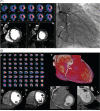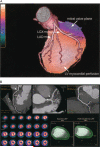Noninvasive imaging in coronary artery disease
- PMID: 25234083
- PMCID: PMC4191722
- DOI: 10.1053/j.semnuclmed.2014.05.004
Noninvasive imaging in coronary artery disease
Abstract
Noninvasive cardiac imaging is widely used to evaluate the presence of coronary artery disease. Recently, with improvements in imaging technology, noninvasive imaging has also been used for evaluation of the presence, severity, and prognosis of coronary artery disease. Coronary CT angiography and MRI of coronary arteries provide an anatomical assessment of coronary stenosis, whereas the hemodynamic significance of a coronary artery stenosis can be assessed by stress myocardial perfusion imaging, such as SPECT/PET and stress MRI. For appropriate use of multiple imaging modalities, the strengths and limitations of each modality are discussed in this review.
Copyright © 2014 Elsevier Inc. All rights reserved.
Figures




References
-
- Murray CJL, Lopez AD. Alternative projections of mortality and disability by cause 1990-2020: Global Burden of Disease study. Lancet. 1997;349:1498–1504. - PubMed
-
- Who . World Health Statistics. World Health Organization; 2008. 2008.
-
- Budoff MJ, Dowe D, Jollis JG, et al. Diagnostic performance of 64-multidetector row coronary computed tomographic angiography for evaluation of coronary artery stenosis in individuals without known coronary artery diseaseresults from the prospective multicenter ACCURACY (assessment by coronary computed tomographic angiography of individuals undergoing invasive coronary angiography) Trial. J Am Coll Cardiol. 2008;52:1724–1732. - PubMed
-
- Miller JM, Rochitte CE, Dewey M, et al. Diagnostic performance of coronary angiography by 64-row CT. N Engl J Med. 2008;359:2324–2336. - PubMed
Publication types
MeSH terms
Grants and funding
LinkOut - more resources
Full Text Sources
Other Literature Sources
Medical

